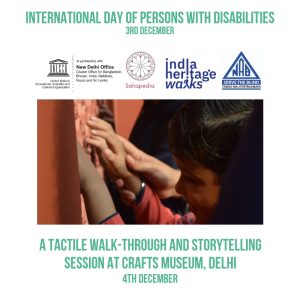- Categories
-
Tags
archaeology art artist arts board games calligraphy ceramics class classical comedy crafts dance design east environment exhibition festival film Flute games heritage hindi hindustani history japanese language latin linguistics literature Mela music odissi painting persian photography play poetry qawwali reading safety sculpture sufi Surajkund symposium talk theater vocal women workshop

Dear Sir/Madam,
Sahapedia, an open-access, online encyclopaedia on Indian culture, heritage and the arts, will hold a series of heritage walks across 16 cities of the country to enlist participation of a wide spectrum of enthusiasts for exploring and preserving the tangible and intangible cultural heritage of the country, as part of World Heritage Week.
Celebrating World Heritage Week- Visit to Nizamuddin Dargah
This magnificent dargah (shrine) in the National Capital invites you for a journey as it spreads the divine light that gives peace to hearts and souls with the essence of rose in the air. It is considered auspicious to be buried near a saint, and this is why there are so many tombs in this corner of Delhi. On our way, we will experience the sights and sounds of the Nizamuddin basti, passing by Urs Mahal, the white-marbled Chausanth Khamba, the little-known tomb of Atgah Khan, and a 14th century baoli. The conversations will revolve around the poetry of Mirza Ghalib, spirituality, qwwalis of Hazrat Amir Khusro and the wonders of the long-gone era.
This guided tour is free.
LISTING
What: Walk | Celebrating World Heritage Week- Visit to Nizamuddin Dargah
Walk Leader: Shashank Gupta
When: Saturday, 24 November 2018
Duration: 4:00 pm to 6:00 pm
Meeting Time: 3:45 pm
Meeting Point: Hazrat Nizamuddin Police Station, near Sabj Burj, Delhi
Things to keep in mind:
-
Mandatory registration closes after 25 entries.
Steps for registration:
- Please like and share the page to register.
- Fill the form to confirm your registration.
(Link to the registration form: https://bit.ly/2FrQMKW)
If you are unable to attend the walk after having registered, please inform us over an email . Email: ihw@sahapedia.org
-
Medium: Bilingual (English /Hindi)
3. No entry fee.
4. Limited parking facilities are available at the meeting point. Paid parking facilities are available at Humayun’s Tomb, which is opposite the meeting point. Charges are to be borne by the participant.
5. Please carry drinking water and wear comfortable shoes. Shoes will have to be removed outside the Sufi shrine.
6. Please carry a scarf/cap to cover the head. Avoid shorts, knee-length clothes or sleeveless attire. Kindly maintain decorum in the dargah.
About Sahapedia
Sahapedia.org is a cultural and educational enterprise of an open-access, online resource on Indian (and South Asian) culture, heritage and the arts, with a strong pan-Indian presence that looks to provide knowledge (through content on their website) along with experiences.

Sahapedia, in partnership with UNESCO, organises multi-city heritage events for persons with special needs
- Events in Delhi, Kolkata, Bhubaneswar, Mumbai, and Amritsar coincide with the International Day of Persons with Disabilities, which falls on December 3
New Delhi, Dec. 01: Ahead of the International Day of Persons with Disabilities, Sahapedia, the open access encyclopaedia of Indian culture and heritage, is organising a series of multi-city events for persons with special needs, in partnership with UNESCO.
The United Nations International Day of Persons with Disabilities (IDPD), which is observed annually across the world on December 3, will focus on the theme of “empowering persons with disabilities and ensuring inclusiveness and equality”.
‘The main aim of these engagements is to enhance the experience of persons with disabilities, so they are not excluded from involvement with India’s rich heritage,” said Vaibhav Chauhan, Secretary, Sahapedia.
Aligned with Sahapedia’s objective of making Indian heritage equally accessible to all groups of society, Sahapedia will be organising the events in five cities – Delhi, Mumbai, Kolkata, Amritsar and Bhubaneswar.
In all of the cities, Sahapedia has collaborated with local partners such as The Maker’s Collaborative (Kolkata), Access for ALL (Mumbai) and the Partition Museum (Amritsar), to execute these activities.
The first event, which was held in Kolkata on November 30, showcased West Bengal’s tradition of BeniPutul or glove puppetry. Conducted by the state’s well-known folk puppeteer BasantaGhorai, the puppetry show was organised for persons with hearing disabilities.
One of the highlights of Sahapedia’s IDPD series is a tactile walk-through and storytelling session at New Delhi’s Crafts Museum, which has a vast repository of over 30,000 artefacts and displays of more than 5,000 objects such as puppets and bronze sculptures. The session, to be held on December 4, will involve examining the museum’s outdoor gallery through tactile exploration with a group of visually challenged women.
At Mumbai’s Anandi Special School, on December 3, a session on folk tales and an art workshop will be held in order to engage children with intellectual disabilities. Other important events include a discussion in Bhubaneswar, on December 2, focusing on
“Breaking Barriers: Exploring the Odisha State Museum with the Visually Impaired.”
Sahapedia’s IDPD week will conclude at Amritsar’s Partition Museum on December 8, where persons with mobility impairment will engage with oral histories and narratives of partition survivors.
Since last year, Sahapedia has organised and curated over 50 heritage-based events for nearly 2,000 differently-abled persons. These include walking tours, sensory experiences in museums and other spaces that support special needs. The events are conducted in collaboration with expert consultants and organisations that are qualified and equipped to facilitate these programmes.
The user-groups that Sahapedia targets are those of the visually impaired, hearing impaired, wheelchair users, those with intellectual disabilities (learning disability, autism and cerebral palsy), reduced mobility, and slow learners.
For the purpose of enhanced heritage experiences, special toolkits are created, which include tactile recreation of culturally relevant topics and Braille books for the visually impaired.

